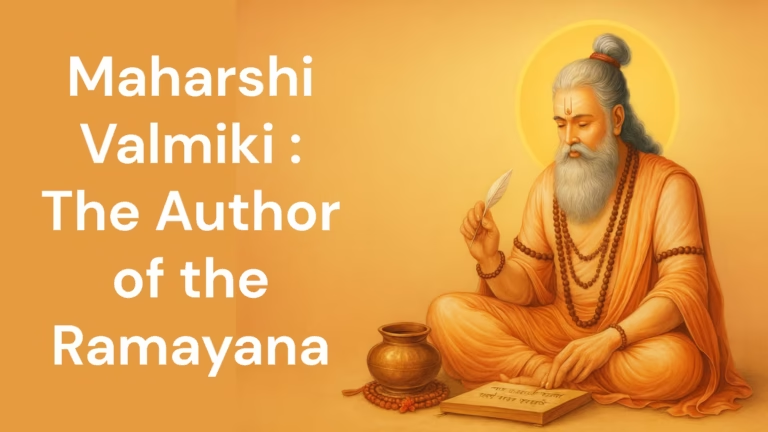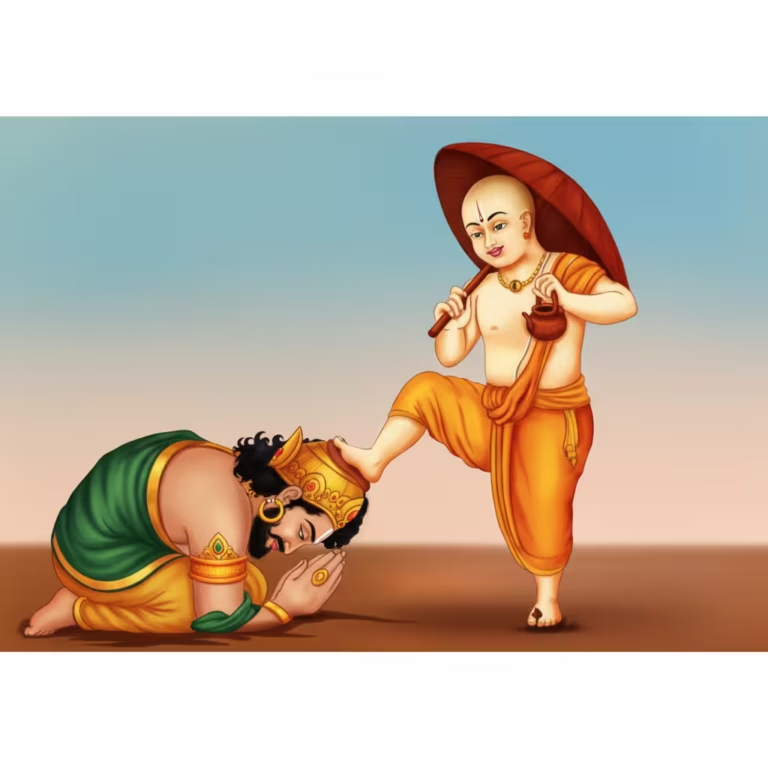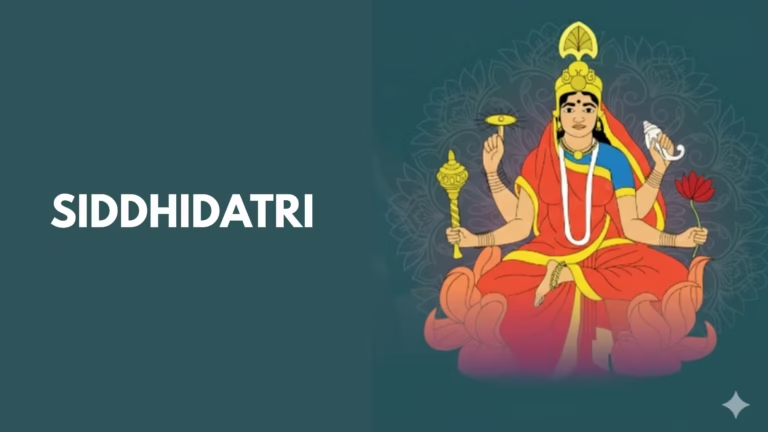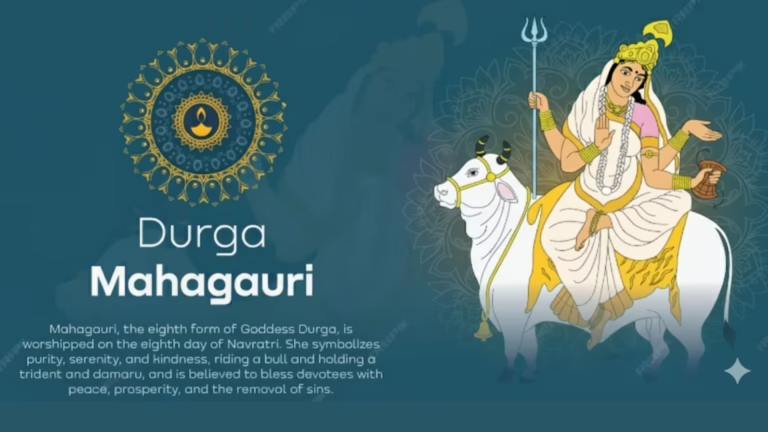Maa Chandraghanta is widely venerated as the third manifestation of the Navadurga. Her glory is celebrated in both Shaiva and Shakta traditions—especially within the Devi‑Bhagavata and the Devi‑Mahatmya tradition of the Markandeya Purana, where the worship of Durga’s many forms is prescribed. Adorned with a crescent‑moon on her forehead, bearing divine weapons, and mounted upon a lion or tiger, she embodies the protection of dharma, the safeguarding of seekers, and the destruction of adharma.
This life‑sketch presents, from a Puranic perspective, the origin of Maa Chandraghanta, her attributes and iconography, narrative context, scripturally grounded modes of worship, and the fruits of practice—so that devotees receive guidance that is faithful to scripture, fact‑minded, and lucid.
Meaning of the Name and Its Symbols
The name “Chandraghanta” unites two symbols: chandra—the crescent moon, and ghanta—the divine, resonant bell. In the Puranic tradition, the Goddess is thus named for the crescent ornament upon her brow and the celestial bell in her hand. The crescent signifies coolness, benevolence, and auspiciousness, while also evoking cyclical time and wakeful awareness. The bell’s sound is held to dispel demons, calamity, and delusion. In this way, the very name proclaims the Goddess’s vocation: the protection of devotees and the preservation of righteousness.
Origin and Metaphysical Form
In the Puranas, the Primordial Shakti of the Supreme (Parabrahman) is extolled as Maya, Yoga, and Vidya. Durga is described as a multiform expansion of this Original Power. In the Devi‑Mahatmya (Markandeya Purana tradition), the Goddess manifests in answer to the gods’ supplication, vanquishing Shumbha‑Nishumbha, Mahishasura, and other demons. The Navadurga—nine worshipful manifestations—are revered within this lineage of worship. Maa Chandraghanta is a radiant conception of this Mahamaya: relentless toward demonic forces, yet a canopy of safety for aspirants.
Philosophically, her form is a union of “fierce serenity”: compassion even within destruction, and public welfare even within valor. Her weapons embody the force that subdues hostile powers, while her gaze toward devotees is described as gracious and fear‑banishing.
The Marriage Episode and the Eruption of Divine Splendor
In Shaiva‑Shakta narrative and Puranic poetry, Parvati—daughter of Himavan—undertakes severe austerities and is wed to Shiva. Within this wider marriage episode, tradition presents the Chandraghanta aspect as swift, valorous, and ready to subdue demonic threats, bearing divine weapons and dispelling fear across the celestial and earthly realms. This is the same Power that, according to scripture, reveals severity toward the wicked and tender mercy toward the devout.
It is vital to remember that, in the Puranas, the Goddess’s many forms are functional expressions of one and the same Supreme Power. In the marriage‑context, the Chandraghanta form conveys her moving radiance—often shown with a lion or tiger as her mount.
Iconography: Weapons, Mount, and Traits
Puranic tradition describes Maa Chandraghanta as multi‑armed, weapon‑bearing, and resplendent, riding a lion or tiger. Principal traits include:
- Crescent on the forehead: the spiritual basis of her name—symbol of coolness, auspiciousness, and conscious awareness.
- The divine bell: the resonant sound in her hand is held to shake demonic hosts; here, sound‑power also signifies mantra‑power.
- Weapons and mudras: trident, sword, bow and arrow, mace, kamandalu, with boons‑bestowing (varamudra) and fear‑dispelling (abhayamudra) gestures—signifying both the destructive and the sustaining sides of the Goddess.
- Mount: lion or tiger—emblems of fierce courage and fearless motion.
- Halo of rays: poetic descriptions speak of a radiance that spreads in all directions, dispelling fear and doubt.
The purpose of such iconography is to show that each limb and implement signifies a divine function: protection, sustenance, dissolution, generosity, and knowledge.
Subjugation of Demons and Protection of Dharma
In the Devi‑Mahatmya and other Shakta narratives, the Goddess appears in answer to the gods’ praises, annihilating the disruptive powers of demons. In the glory associated with Chandraghanta, the message is one of demolition through sound‑power and decisive weaponry. This is not destruction for its own sake but the guardianship of dharma—quelling adharma and establishing fearlessness within the community of seekers.
Tradition reiterates that the Goddess’s wrath is for the wicked, and her grace is for devotees; for those who walk the dharmic path, she remains ever auspicious.
Scriptural Basis of Worship
Shakta texts and Puranic tradition root the Goddess’s worship in mantra, meditation, hymnody, and ritual purity. Within the Navadurga observances, the third day’s worship of Chandraghanta is firmly established, integrated with the recitation of the Devi‑Mahatmya, Durga hymns, and the customary Shakta disciplines.
Essential elements of worship include:
- Purity and resolve (shuchita and sankalpa): pure diet, truth‑observance, and the resolve to worship the Goddess.
- Core recitations: the Devi‑Mahatmya (central to the Navadurga tradition), the Durga Chalisa, and other hymns enumerating the Goddess’s qualities—with priority given to scriptural recitation.
- Mantra‑japa: Chamunda mantra lineages and Durga bija traditions are part of Shakti‑worship; aspirants set their counts in obedience to the instructions of their lineage‑guru.
- Invocation and arati: invocation, offerings, naivedya, lamp‑worship, and the shanti‑path.
The Puranas also teach that a pure heart, truthfulness, compassion, and adherence to dharma are the highest forms of worship. Outer rites bear fruit only when inner discipline and conduct are kept pure.
Fruits of Practice: Scriptural Assurances
Puranic tradition defines the fruits of practice not so much as outer siddhis as the awakening of inner power. The principal fruits of Chandraghanta worship are described as:
- Removal of fear and bestowal of fearlessness: the lessening of fear, doubt, and weakness in the devotee’s heart.
- Valor and fortitude: steadiness, fearlessness, and moral resolve amid difficult fields of action.
- Removal of obstacles: the subduing of undharmic and demoniac tendencies.
- Reputation and public‑welfare intent: a turn from merely private gain toward the welfare of all.
These fruits abide only alongside restraint, the discipline of the guru‑parampara, and fidelity to scripture.
Practical Teaching of the Chandraghanta Form
The Puranic narratives aim not merely at telling of demon‑slayings but at laying down a formula for righteous living. The Chandraghanta form teaches that life requires a balance of courage and compassion. In the face of fear and injustice, the response should be dharmically grounded resistance—held together with inner coolness, discernment, and self‑control. This equilibrium is the heart of sadhana.
Chandraghanta in the Context of the Navadurga
The Navadurga—the nine worshipful currents of Shakti—guide the aspirant, step by step, toward purity, valor, knowledge, compassion, and integration. On the third day of worship, remembrance of Chandraghanta implants the samskara of courage and fearlessness. Although the day‑wise order of rites is harmonized by traditional texts and teachers, the core understanding remains: all forms are dimensions of the single Supreme Power.
Outline of Scriptural References
- Markandeya Purana — Devi‑Mahatmya (tradition of the Durga Saptashati): narratives of the Goddess’s epiphany, the gods’ praises, and the subjugation of demons.
- Devi‑Bhagavata Purana: extensive treatment of the Goddess’s forms and the discipline of worship.
- Kalika Purana and other Shakta works: Shakti doctrine, worship, and calendrical considerations.
The unifying thread across these sources is that Chandraghanta expresses the Goddess’s fierce‑peaceful nature, manifesting for the protection of dharma and the safeguarding of seekers.
Frequently Asked Questions (FAQ)
Is Maa Chandraghanta explicitly mentioned in the Puranas?
The doctrine of the Goddess and the many forms of Durga are elaborated in the Devi‑Bhagavata and the Markandeya Purana tradition. The Navadurga worship is a tradition sanctioned by these scriptural streams; Chandraghanta is counted among these worshipful forms.
Is her mount a lion or a tiger?
Both mentions are found in tradition. To evoke the fierceness and fearlessness of Shakti, poetry and iconography sometimes show a lion and sometimes a tiger.
Are specific colors, flowers, or offerings fixed by the Puranas?
The Puranas primarily lay down doctrine, ethics, and discipline. In later devotional practice, local customs grew regarding colors, flowers, and offerings. Prioritize scriptural recitation and inner purity over such later accretions.
Is there a compulsory text to recite?
The recitation of the Devi‑Mahatmya, Durga hymns, and the mantra‑japa received from one’s guru are established and safe paths. In practice, the guru‑upadisht (guru‑taught) method is paramount.
Maa Chandraghanta’s life‑sketch teaches that tenderness alone does not suffice for the protection of dharma; one also needs a balance of valor and restraint. In the Puranic tradition, her form assures public protection, the destruction of adharma, and the welfare of seekers. The essence of worship lies in a pure heart, truthfulness, scriptural recitation, and obedience to the guru. Following this path makes the aspirant fearless, discriminating, and committed to the welfare of all.
Read Also :



